Understanding Compassion in Therapy for Anxiety
Anxiety affects millions and can be a debilitating condition, but emerging therapeutic approaches rooted in compassion are offering new hope. Compassion-Focused Therapy (CFT) and self-compassion practices are reshaping how anxiety is managed by teaching individuals to treat themselves with kindness and understanding rather than self-criticism. This article explores compassionate therapy techniques, their underlying science, and practical methods to support emotional regulation and well-being in the face of anxiety.
What is Compassion-Focused Therapy (CFT) and How Does It Manage Anxiety?
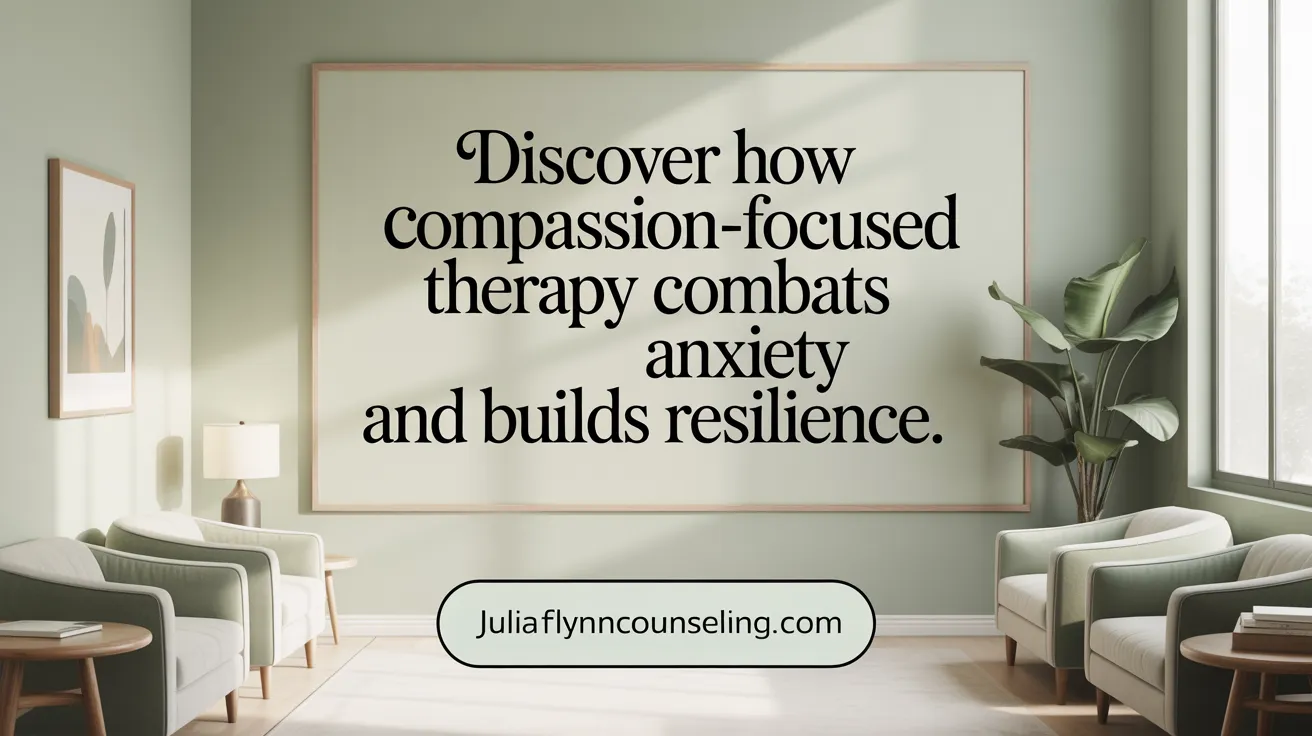
What is compassion-focused therapy (CFT) and how is it used to manage anxiety?
Compassion-Focused Therapy (CFT) is an evidence-based psychotherapy designed to help individuals who experience intense shame and self-criticism, which often contribute to anxiety and mood disorders.
Developed by Dr. Paul Gilbert, CFT synthesizes principles from evolutionary psychology, neuroscience, biology, and Buddhist thought. It aims to cultivate self-compassion and compassion for others to regulate emotional distress.
CFT incorporates various techniques such as compassionate imagery, mindfulness, soothing rhythm breathing, and creating safe mental spaces. These practices help individuals soothe their nervous systems and develop a kinder, more supportive inner voice.
This therapy targets the imbalance among three key emotion regulation systems: threat and self-protection, drive and excitement, and soothing and social safety. Often, the threat system dominates, leading to heightened anxiety.
By training individuals to foster compassion—toward themselves and others—CFT activates the soothing system, which counters the overactivation of threat responses. This balance reduces feelings of shame, self-criticism, and anxiety, supporting psychological resilience.
High-quality research shows that CFT can effectively decrease self-criticism and shame, leading to lower anxiety levels. It promotes emotional regulation, self-kindness, and feelings of safety—all vital for managing anxious thoughts and behaviors.
Overall, CFT offers a compassionate pathway to understanding and transforming inner experiences, helping people live with greater courage and ease despite ongoing worries.
Therapeutic Techniques that Incorporate Compassion and Self-Compassion for Anxiety Relief
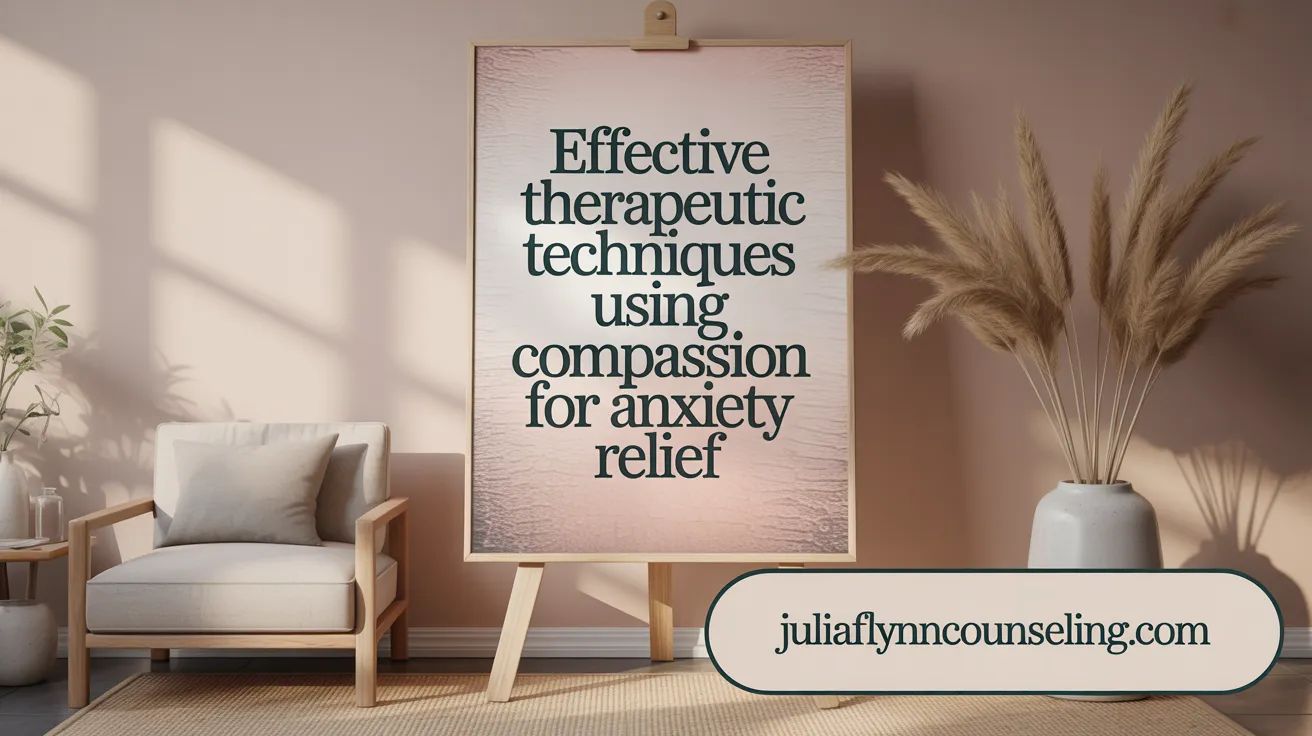
What therapeutic techniques incorporate compassion and self-compassion to relieve anxiety?
Therapies focusing on compassion and self-compassion have gained recognition for their effectiveness in reducing anxiety. Central to these methods is Compassion-Focused Therapy (CFT), which emphasizes exercises like compassionate imagery, mindful breathing, and the development of a compassionate self.
One of the primary techniques involves compassionate imagery and visualization. Clients are guided to imagine a safe and warm environment or to visualize a compassionate figure providing comfort. This practice helps activate the brain’s caregiving system, fostering feelings of safety and warmth. These exercises encourage kindness towards oneself, especially during moments of distress, which can lessen feelings of shame and self-criticism often associated with anxiety.
Mindful breathing exercises and safe place visualizations are also integral. Techniques such as soothing rhythm breathing help regulate physiological responses, calming the nervous system. By creating a mental safe space, individuals learn to observe their anxious thoughts without judgment, promoting a compassionate attitude and emotional resilience.
Compassionate mind training (CMT) is another structured approach. It involves guided activities like role-playing, compassionate self-talk, and visualization to cultivate an inner supportive environment. These exercises strengthen the connection to the core self—a source of innate compassion—and help balance the brain’s emotional regulation systems.
In addition, integration with mindfulness practices enhances these techniques. Clients are encouraged to notice their thoughts and feelings with compassion, rather than avoidance or self-criticism. Mindfulness-based approaches like meditation and body scans reinforce present-moment awareness while nurturing kindness towards oneself.
Importantly, these techniques activate the caregiving or soothing system in the brain, which counteracts the overactivation of threat and drive systems linked to anxiety. By engaging this system, individuals can experience increased feelings of safety, reduce stress, and develop a gentler, more accepting self-view.
Effective use of compassion and self-compassion exercises provides a powerful toolkit for managing anxiety. These methods support emotional regulation, build resilience, and help individuals respond to distress with warmth and understanding, ultimately contributing to a calmer, more balanced mental state.
Practical Self-Compassion Exercises and Their Role in Managing Anxiety
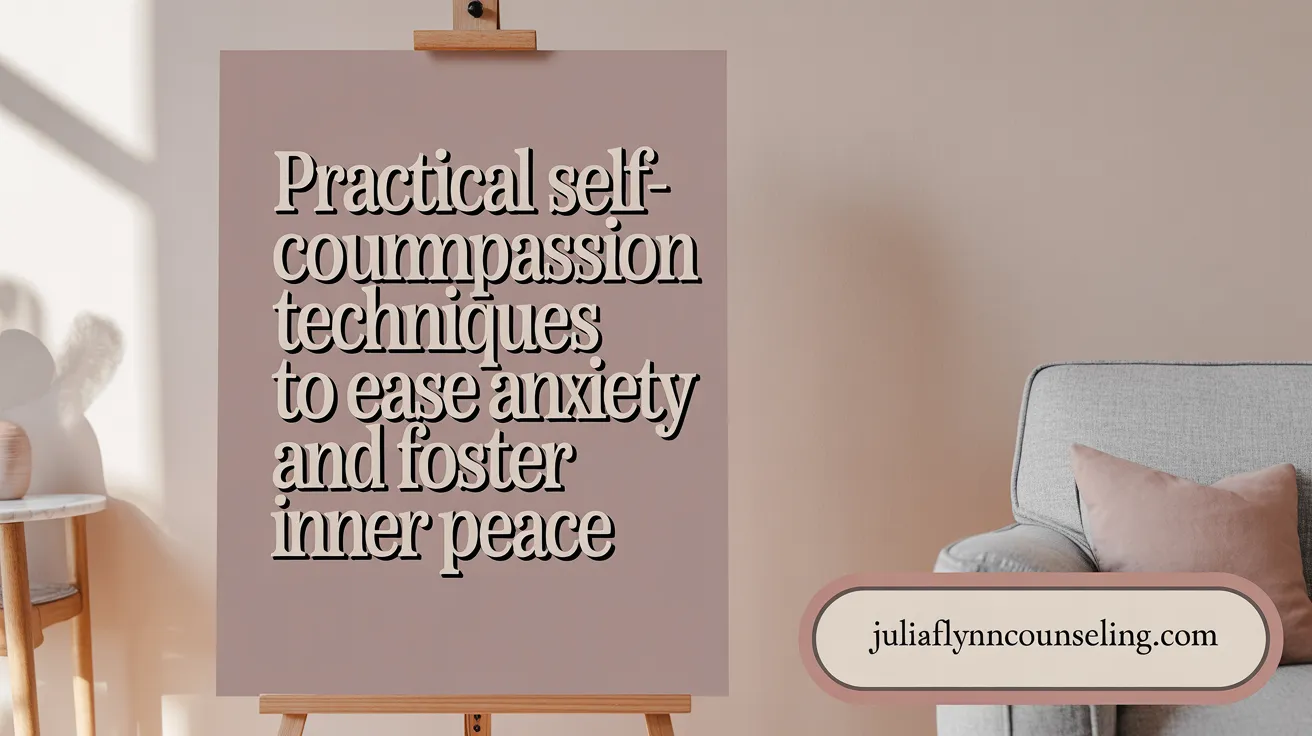
What are some effective self-compassion practices?
Self-compassion practices involve engaging in activities that promote kindness, mindfulness, and common humanity in relation to oneself. These practices aim to counteract negative self-talk and self-criticism, which can exacerbate anxiety.
What exercises like Self-Compassion Break and letter writing can help?
The Self-Compassion Break is a guided exercise that encourages individuals to pause, acknowledge their feelings, and offer themselves kindness and reassurance. Writing a compassionate letter to oneself is another powerful activity; it involves expressing understanding and support, much like writing to a caring friend. These exercises help normalize suffering and foster an emotional environment where self-acceptance and patience flourish.
How do guided meditations and mindfulness exercises contribute?
Guided meditations and mindfulness exercises, such as loving-kindness meditation and body scans, direct attention towards present-moment awareness and self-care. They assist individuals in observing their thoughts and feelings without judgment, reducing emotional reactivity and promoting calmness.
How do these practices reduce self-criticism and emotional distress?
Engaging regularly in self-compassion exercises cultivates a more supportive inner dialogue, which diminishes harsh self-judgment. This shift can lower levels of distress, anxiety, and avoidance behaviors. As individuals learn to treat themselves with kindness, they often experience less shame and guilt, common emotional underpinnings of anxiety.
What resources are available to support these practices?
Various workbooks, online courses, and recordings of guided meditations are available to assist individuals in developing self-compassion. For example, workbooks with modules covering understanding self-compassion, overcoming barriers, and practicing compassionate imagery provide practical strategies. Additionally, downloadable meditations and self-compassion exercises help integrate these practices into daily life.
| Practice Type | Description | Benefits | Additional Resources |
|---|---|---|---|
| Self-Compassion Break | Short guided pauses during distress | Immediate emotional relief, increased awareness | Guided recordings, apps |
| Writing a Letter | Expressing kindness to oneself | Enhances self-understanding and acceptance | Workbooks, online templates |
| Guided Meditations | Mindfulness and loving-kindness | Reduces rumination, promotes calm | Meditation apps, YouTube videos |
| Journaling | Daily self-compassion entries | Builds resilience, tracks progress | Self-compassion journals, prompts |
How do these practices support anxiety management?
By fostering a more supportive and forgiving inner voice, self-compassion exercises reduce feelings of self-criticism, shame, and fear—factors often fueling anxiety. These practices help individuals develop emotional regulation skills, enabling them to face anxiety-provoking situations with greater resilience and less avoidance. Incorporating regular self-compassion exercises into mental health routines can be a significant step toward long-term anxiety relief and emotional well-being.
How Compassion-Based Approaches Enhance Emotional Regulation and Mental Well-Being
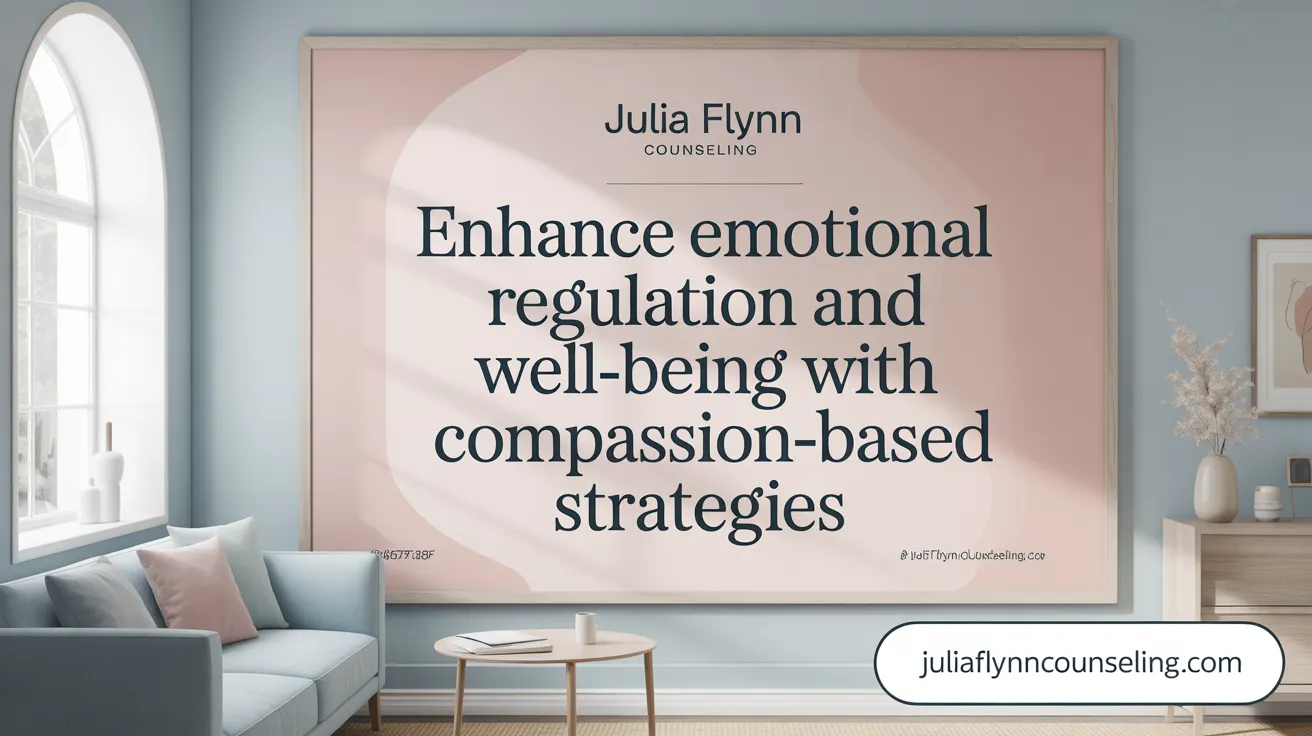
How do compassion-based approaches improve emotional regulation and mental well-being?
Compassion-focused therapies, such as Compassion-Focused Therapy (CFT), fundamentally transform how individuals manage their emotions by promoting a kind and accepting attitude towards oneself. This gentle stance helps reduce the brain's threat sensitivity, which is often heightened in conditions like anxiety and depression. When people practice compassion, it activates neural regions associated with positive feelings—such as reward and social connection—leading to increased feelings of safety and well-being.
Research shows that developing self-compassion and compassionate responses fosters better emotion regulation strategies. For instance, techniques like cognitive reappraisal, which involve reframing negative thoughts, become more effective when someone approaches themselves with kindness. Conversely, responses that involve suppression or criticism tend to worsen mental health by maintaining or amplifying negative emotions.
Interventions such as Compassionate Mind Training, mindfulness exercises, and self-compassion programs have been shown to boost feelings of kindness towards oneself, reducing symptoms of anxiety and depression. These practices not only cultivate positive emotional states but also encourage resilience and emotional flexibility.
Importantly, compassion-based methods are effective across diverse populations. Studies with adolescents, autistic adults, and mental health professionals demonstrate improvements in emotional regulation, highlighting the broad applicability of these approaches. Overall, nurturing compassion helps regulate emotions more adaptively, fostering mental health and well-being in a variety of contexts.
| Mechanisms | Neural Effects | Mental Health Outcomes | Populations Benefited |
|---|---|---|---|
| Developing self-kindness | Increased activity in brain regions related to positive affect | Reduced anxiety and depression | Adolescents |
| Compassionate responding | Activation of reward and affiliation pathways | Enhanced resilience and emotional flexibility | Autistic adults |
| Mindfulness and compassion exercises | Lower threat perception, calmer autonomic response | Better emotion regulation, improved self-esteem | Mental health professionals |
Addressing Social Anxiety and Other Anxiety Disorders Through Compassionate Therapy
What are the core symptoms of social anxiety?
Social anxiety is characterized by intense fear or worry about social situations, often accompanied by self-consciousness, embarrassment, and fear of negative evaluation. People with social anxiety may go to great lengths to avoid social interactions, which can impair daily functioning and limit opportunities for social engagement.
How does Compassion-Focused Therapy (CFT) help with social anxiety?
CFT approaches social anxiety and other anxiety disorders by focusing on developing self-compassion and reducing self-critical thoughts. Techniques such as compassionate imagery, mindfulness exercises, and compassionate self-talk help individuals build a supportive internal dialogue. This fosters a sense of safety and acceptance, countering the threat-based feelings often present in social anxiety.
CFT aims to activate the soothing systems in the brain, promoting feelings of safety and connectedness. By normalizing social mistakes and encouraging self-kindness, individuals can reduce shame and self-criticism—major contributors to social anxiety. Mindfulness practices, including focusing attention on compassionate feelings, help manage anxious thoughts without judgment.
What are some complementary approaches like CBT, exposure therapy, and mindfulness?
CFT can be effectively combined with cognitive-behavioral therapy (CBT), which challenges negative thoughts about oneself and others. Exposure therapy gradually helps clients confront feared social situations in a controlled, supportive manner.
Mindfulness and relaxation techniques, such as deep breathing and body scans, are also integrated to manage physical symptoms of anxiety. These practices promote present-moment awareness and calmness, making it easier to face social situations with confidence.
How do self-compassion practices reduce self-criticism and avoidance behaviors?
Practicing self-compassion entails treating oneself with kindness during times of social difficulty. Exercises include writing compassionate letters to oneself, using loving-kindness meditations, and maintaining journals focused on self-support.
These practices help diminish self-critical tendencies, which often reinforce anxious avoidance of social scenarios. When individuals view their flaws with understanding rather than judgment, they become more willing to engage socially, reducing feelings of shame and increasing resilience.
How can these approaches foster social confidence and emotional regulation?
Compassionate therapies cultivate emotional regulation by activating the soothing system, which counters the hyperactivity of threat responses typical in anxiety. Developing a compassionate inner voice boosts confidence and encourages social risk-taking.
Skills like emotion regulation, mindfulness, and self-kindness contribute to better coping strategies in social contexts. Over time, these tools help individuals manage overwhelming feelings, respond with calmness, and build genuine social confidence.
| Strategy | Techniques | Benefits |
|---|---|---|
| Compassion-focused | Imagery, meditations, reevaluation of self-criticism | Reduce shame, foster self-acceptance |
| Cognitive-behavioral | Thought challenging, behavioral experiments | Change negative beliefs |
| Exposure therapy | Graduated social exposure | Decrease avoidance |
| Mindfulness | Body scans, loving-kindness | Enhance emotional awareness |
Understanding and applying these strategies can provide a comprehensive pathway for managing social anxiety, promoting emotional resilience, and fostering social engagement.
Integrating Compassion-Based Techniques into Ongoing Anxiety Management
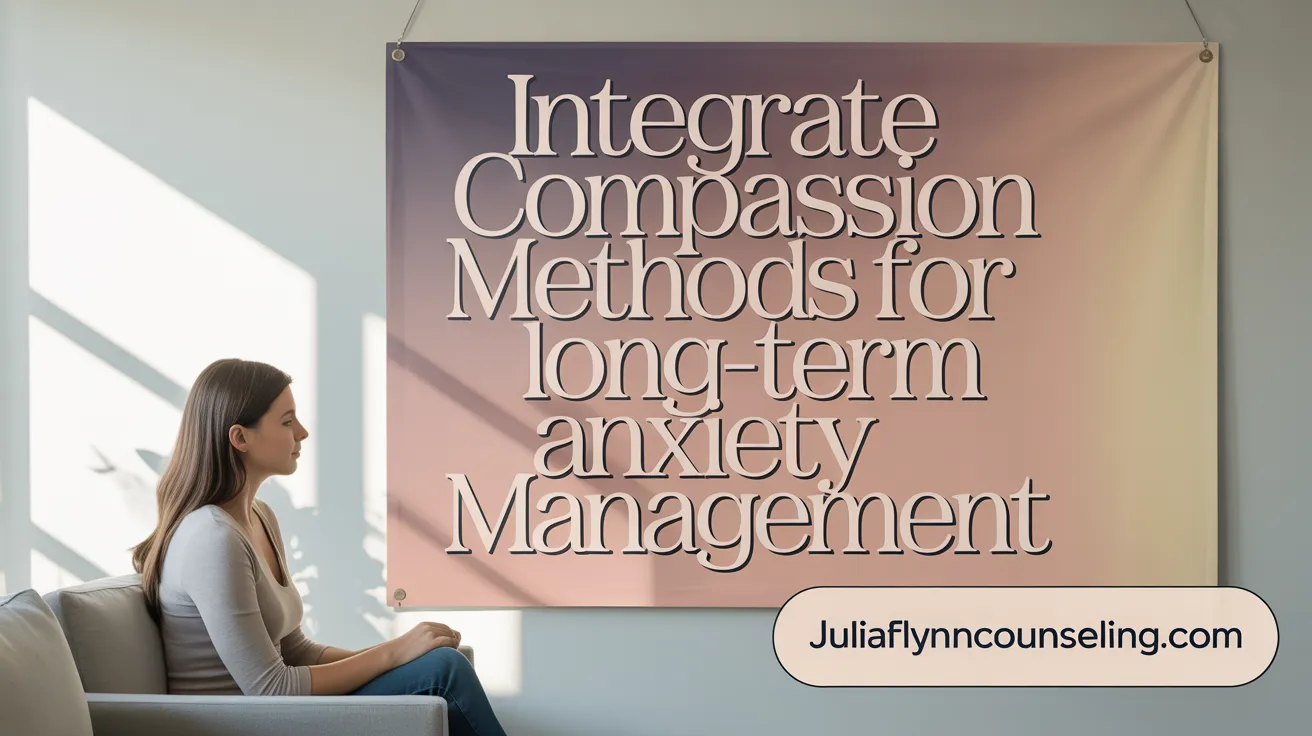
Long-term resilience building through self-compassion
Developing self-compassion is essential for managing anxiety over the long term. It involves treating oneself with kindness, patience, and understanding during difficult times. Regular practices like mindful self-awareness, compassionate imagery, and journaling about positive self-affirmations cultivate a supportive inner voice. These habits help reduce self-critical thoughts and foster emotional resilience, enabling individuals to better cope with ongoing stress and setbacks.
Combining CFT with CBT and Internal Family Systems Therapy
Effective anxiety treatment often benefits from integrating multiple approaches. Compassion-Focused Therapy (CFT) emphasizes nurturing self-kindness and addressing shame, while Cognitive-Behavioral Therapy (CBT) targets negative thought patterns and behaviors. Internal Family Systems (IFS) therapy explores different parts of the self, promoting compassion toward these parts to reduce inner conflict. Combining these therapies creates a comprehensive framework that improves self-understanding, reduces avoidance, and enhances emotional regulation.
Practical daily practices and resources for sustained benefits
Daily routines such as the "Self-Compassion Break," writing supportive letters to oneself, and engaging in loving-kindness meditation can promote lasting change. Using structured workbooks that focus on understanding, barriers, compassionate imagery, and living in alignment with compassionate values further supports progress. Many online resources, guided recordings, worksheets, and mobile apps are available to help individuals cultivate compassion amidst busy schedules, ensuring continuous practice and growth.
Role of therapists and training requirements
Therapists trained in CFT and related compassion-focused approaches are equipped to guide clients through exercises like compassionate imagery, mindfulness, and soothing techniques. Specialized training in these methods ensures practitioners can deliver effective interventions tailored to complex emotional issues such as shame and self-criticism. Ongoing education and certification programs are available for clinicians wishing to deepen their expertise in compassion-based therapy.
Future outlook on compassionate approaches for pandemic-era anxiety challenges
As the world continues to face the mental health repercussions of the pandemic, compassion-oriented therapies like CFT are becoming increasingly vital. They offer a gentle yet effective framework for building resilience, reducing shame, and promoting well-being. Advances in digital delivery, including online workshops and guided practices, expand access to these approaches. The integration of compassion into mainstream mental health care holds promise for addressing the widespread and long-lasting impacts of global crises on mental health.
Compassion as a Cornerstone for Anxiety Relief and Emotional Health
Compassionate therapy techniques, led by Compassion-Focused Therapy and enriched with self-compassion practices, offer a transformative way to navigate anxiety. By shifting the internal dialogue from harsh self-criticism to gentle understanding, these methods foster emotional resilience, regulate threatening brain systems, and promote a sense of safety and well-being. Whether addressing social anxiety or generalized anxiety, compassion-based approaches equip individuals with practical tools and supportive mental frameworks for enduring mental health. Continuing advancements and dissemination of compassionate therapy hold promising potential in alleviating anxiety’s widespread impact and cultivating healthier minds and communities.
References
- 16 Compassion Focused Therapy Techniques & Exercises ...
- Self-Compassion in Reducing Anxiety - Chicago
- Self-Compassion Practices: Cultivate Inner Peace and Joy
- How to Help Someone with Anxiety: 5 Compassionate ...
- Self-Compassion Self-Help Resources
- Compassion-Focused Therapy
- Mindfulness-Based Interventions for Anxiety and Depression
- Social Anxiety - Home | Compassionate Healing
